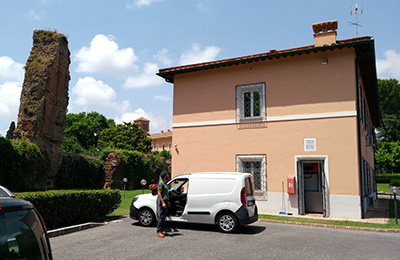Procurement office of the catholic church
Procurement office building refurbished in Rome, Italy. The EnerTwin was implemented to cover new energy-demand and sustainability goals in a cost-efficient way. Costly adaptations to the building structure to accommodate low-temperature heating systems were avoided. With >5000 runhours per year a great return on investment was achieved.
Context
According to the Energy Performance of Building Directive (EPBD, Europe), Commercial office buildings require energy label improvement. This applies to all existing office buildings. Monuments and historic heritage are exempt from the implementation of EPBD.
Not only companies are increasingly faced with CSR and environmental challenges by customers as well as shareholders and local authorities, but many other social enterprises as well. Reduction of the company carbon footprint (both CO2 and NOx emissions) is on religious agenda’s too.
The Use Case
- Location: Vatican procurement office Rome, Italy
- Requirements: With the implementation of EPBD for this building coming up, combined with the sustainability plan of the Vatican a more radical change was due. The company required strong improvement of the energy-performance and various options were investigated. Silent operation, as the unit would be operating in the proximity of the office staff, was mandatory.
- Solution: Engine-based CHP systems were therefore found unsuitable for the silent operation requirement. The building would also not allow for costly changes for low-temperature systems that are required by other systems such as heatpumps or fuel-cells. The Vatican procured an EnerTwin in order to efficiently produce both heat and power.
The installation and role of the EnerTwin
Engineering and installation was performed by ATET Energy Solutions. The challenge was initiated by replacement of a traditional condensing boiler due to age. The EnerTwin is installed in a shared heating room for a 2 level office building. In this set-up, the EnerTwin is connected to a buffer vessel and supported by a extra boiler covering peak loads, which itself is connected to the main heating circuit of the building.
EnerTwin is placed (see picture) in a very small housing, in which no other engine-based CHP systems would fit.
Factual results of the project
- Installation costs: € 3000
- Annual running hours: 5000+ hrs
- Electricity produced: 10000+ kWh
- Existing condensing boilers used for peakloads
- Reliable heating solution covering 90% of heatload
- Subventions have been granted
- Climate goals have been achieved with CO₂ and NOₓ emissions reduced by 6,5 Tons a year
- Silent operation, inaudible for office staff
- Plug&Play installation with little impact on operations of the company
Feedback of the project team:
- Sustainability goals for the end-user were considered an important step into the future of the Vatican. Providing electrical energy for office-use whilst the building was heated by the EnerTwin at high efficiency was a very satisfying concept for the procurement office.
- The results that surfaced after the first year of operation regarding CO2 reduction based on the runhours were impressive. By installing a buffervessel, the runhours created more continuous operation and more runhours.
- The client was positively surprised by the impact on the end-users and ease of implementation, considering application in other real-estate in their portfolio.



